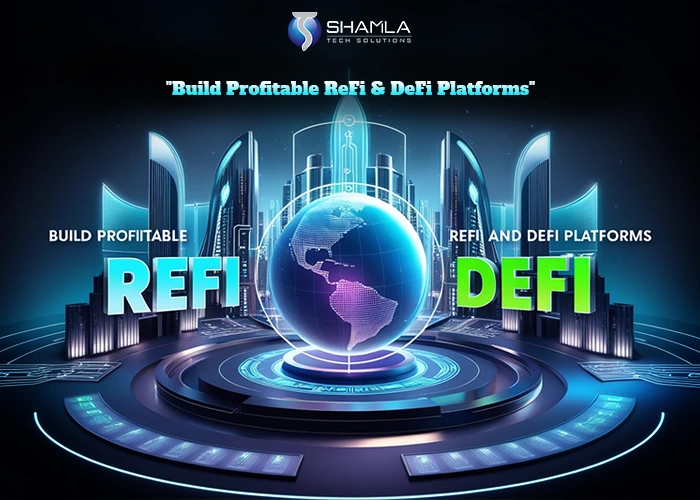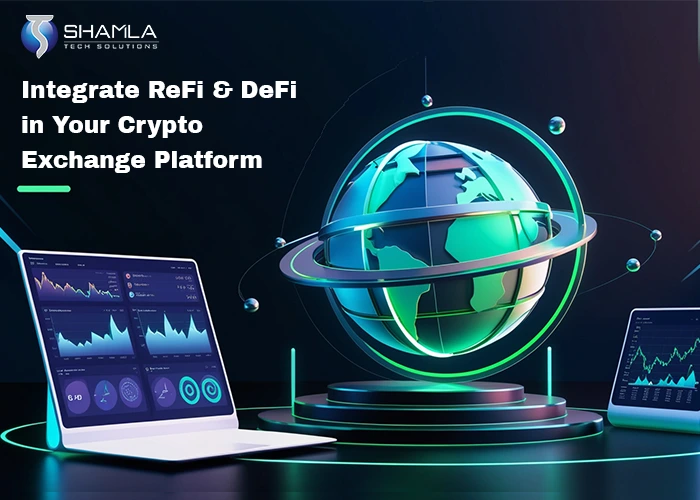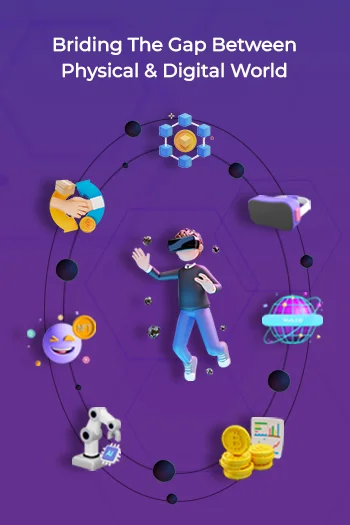ReFi vs DeFi the Future of Sustainable Finance in Crypto and Decentralized Finance (DeFi) are redefining capital flows in blockchain ecosystems. While DeFi optimizes yield generation, liquidity provisioning, and smart contract automation, ReFi integrates ecological sustainability, impact-driven tokenomics, and carbon credit tokenization into financial mechanisms. Protocols leveraging zero-knowledge proofs, DAO governance, and on-chain verifiable sustainability metrics are shaping next-gen financial instruments. With innovations like regenerative yield farming and algorithmic climate assets, ReFi extends beyond DeFi’s yield-first paradigm by internalizing externalities. As Web3 infrastructure matures, cross-chain interoperability, layer-2 scaling, and MEV-resistant sustainability incentives will dictate whether ReFi emerges as a major shift or remains a niche subset.
Contact Us for a Free Consultation and Custom Quote
ReFi vs DeFi: Sustainable Finance in Crypto
Aspect | DeFi | ReFi |
Primary Focus | Financial services without intermediaries | Finance with a focus on sustainability and impact |
Core Technology | Blockchain, Smart Contracts, AMMs | Blockchain, Tokenization, Eco-Credits |
Governance | Decentralized governance through tokens (e.g., UNI) | Decentralized governance focused on environmental impact |
Market Purpose | Enabling decentralized lending, borrowing, and trading | Enabling eco-friendly projects and carbon credit markets |
Asset Backing | Cryptocurrencies and digital assets | Tokenized carbon credits, nature-backed assets |
Liquidity | Liquidity pools in decentralized exchanges (DEXs) | Eco-asset-backed liquidity pools, tokenized sustainability |
Economic Model | Yield farming, liquidity provision, staking | Sustainable yield generation, impact investing |
Risk Exposure | High market volatility, impermanent loss | Potential eco-impact measurement risks and scalability challenges |
Scalability | Focus on Layer 2 scaling and cross-chain compatibility | Growing with eco-impact protocols but faces scalability issues |
Impact Focus | Financial empowerment and yield optimization | Regenerative outcomes, environmental sustainability |

What Is DeFi?
Decentralized Finance (DeFi) is an open financial system built on blockchain networks. It uses smart contracts to allow trustless transactions without the need for middlemen. The main parts of DeFi include Automated Market Makers (AMMs), decentralized exchanges (DEXs), lending services, synthetic assets, and ways to earn interest. Liquidity in AMMs comes from bonding curves and methods to reduce temporary loss, while lending services use overcollateralization and systems to force the sale of assets when necessary, with help from oracle networks like Chainlink. Popular platforms like Aave and Compound use interest rate models, adjustable collateral amounts, and rewards with governance tokens. DeFi’s growth is supported by Layer-2 rollups, zk-SNARKs, and state channels, which help increase speed, reduce fees, and improve transaction processing.
Composability, also called “money legos,” lets DeFi protocols connect easily, creating cooperation much better across different parts of the system. Flash loans use atomic execution, which also allows for arbitrage, collateral swaps, and liquidation bots without needing any money upfront. Cross-chain bridges, which use wrapped assets and special cryptography, increase liquidity across different blockchain networks. AI-powered crypto exchange development enhances the efficiency of decentralized platforms. Governance models, from DAOs to veTokenomics, control how protocols grow through on-chain voting and rewards for staking. Security problems, like reentrancy attacks, front-running with MEV (Maximal Extractable Value), and oracle manipulation, need formal checks and careful smart contract audits.
Regenerative Finance (ReFi) integrates sustainability mechanisms into blockchain-based financial systems, embedding environmental and social impact within tokenized economies. Unlike DeFi’s yield-maximizing frameworks, ReFi internalizes externalities through carbon credit tokenization, regenerative yield farming, and impact-driven collateral models. Protocols such as Toucan and KlimaDAO use blockchain-based MRV (Measurement, Reporting, and Verification) systems, ensuring transparency in offset markets. Zero-knowledge proofs and decentralized oracles authenticate carbon sequestration data, mitigating double-spending risks. Regenerative assets leverage quadratic funding, retroactive public goods funding, and bonded staking models to align incentives for ecological restoration, optimizing capital deployment towards sustainable infrastructure and climate-positive economic activities.
Interoperability in ReFi hinges on cross-chain sustainability data verification, integrating modular blockchains with impact-led DAOs and ReFi-native stablecoins backed by nature-based assets. Smart contracts automate real-world asset (RWA) tokenization, enabling decentralized green bonds and biodiversity credits. MEV-resistant incentive structures prevent extractive arbitrage in sustainability markets, reinforcing long-term ecosystem resilience. ReFi also employs governance mechanisms such as soulbound tokens and reputation-weighted voting to prevent speculative extraction while ensuring stakeholder alignment. As ReFi scales, modular architectures, layer-2 scalability solutions, and decentralized identity (DID) frameworks will dictate adoption, merging regenerative economics with programmable financial infrastructure. The ongoing discussion of ReFi vs DeFi also highlights the contrasting priorities, with ReFi focusing on sustainability while DeFi centers around decentralized financial systems.

The Core Differences Between DeFi and ReFi
1. Economic Incentives and Yield Models
DeFi prioritizes capital efficiency, leveraging algorithmic liquidity pools, automated market makers (AMMs), and leveraged yield strategies. Interest rate mechanisms in protocols like Aave and Compound dynamically adjust based on supply-demand curves. In contrast, ReFi integrates regenerative yield models where staking rewards, liquidity incentives, and asset appreciation are tied to ecological and social impact metrics. Carbon-backed assets, impact-driven bonds, and sustainability-indexed stablecoins embed real-world utility into financial returns. While DeFi optimizes for arbitrage opportunities and liquidity depth, ReFi structures incentives around long-term environmental and social value accrual, reshaping capital deployment towards regenerative and circular economic models.
2. Asset Composition and Collateralization Models
DeFi collateral primarily consists of crypto-native assets like ETH, stablecoins, and tokenized derivatives, with risk mitigation through overcollateralization and liquidation engines. Synthetic assets enable exposure to off-chain commodities and equities. ReFi vs DeFi underscores the fundamental shift in value creation, DeFi optimizes speculative efficiency, whereas ReFi aligns finance with regenerative outcomes. ReFi, however, tokenizes nature-based assets, carbon credits, and real-world impact metrics as collateral. Projects like Flowcarbon and Celo tokenize verifiable climate-positive assets, while automated Measurement, Reporting, and Verification (MRV) systems validate ecological contributions. Smart contracts enforce sustainability commitments, ensuring asset value is linked to real-world impact. The best crypto exchanges in USA 2024 are increasingly exploring both models, offering a range of decentralized and regenerative finance options for users.
3. Governance Mechanisms and Stakeholder Participation
DeFi governance operates through DAOs, veTokenomics, and on-chain voting, where governance tokens dictate protocol upgrades and treasury allocations. Participation often skews towards token-weighted voting, leading to governance capture by large stakeholders. ReFi introduces novel governance frameworks incorporating soulbound tokens, reputation-weighted voting, and impact-based decision-making. Quadratic voting and decentralized identity (DID) mechanisms prevent governance plutocracy while aligning incentives with long-term regenerative impact. ImpactDAOs allocate resources to sustainability projects based on verifiable contributions rather than pure capital weight, ensuring equitable stakeholder representation. This explains why it is better to go for decentralization over a centralized crypto exchange development company.
4. Market Dynamics and Capital Flow Models
DeFi thrives on permissionless liquidity markets, flash loans, leveraged trading, and MEV-exploitable inefficiencies that enable arbitrageurs and liquidity providers to extract value. Market depth, trading volume, and transaction velocity dictate protocol sustainability. ReFi, by contrast, reconfigures capital flows to fund regenerative projects via tokenized green bonds, circular economies, and public goods funding. Regenerative yield farming programs redistribute protocol fees to climate-positive initiatives rather than liquidity mercenaries. Impact-driven DeFi primitives emerge within ReFi, ensuring that capital cycling supports tangible environmental and social outcomes rather than extractive trading strategies optimized for short-term yield maximization.
5. Regulatory Landscape and Compliance Considerations
DeFi operates in a gray regulatory zone, with decentralized exchanges (DEXs), lending protocols, and synthetic assets facing scrutiny over KYC/AML compliance and systemic risk. Pseudonymous transactions, cross-chain bridges, and permissionless token issuance raise regulatory concerns. ReFi, however, aligns more closely with compliance frameworks due to its integration with ESG reporting, verifiable carbon markets, and tokenized real-world assets. Blockchain-based MRV systems enhance regulatory transparency, reducing greenwashing risks. Partnerships between ReFi projects and institutions like the World Bank or climate-focused DAOs pave the way for legal recognition. This structural difference positions ReFi as a more regulation-friendly evolution of DeFi.
6. Long-Term Sustainability and Ecosystem Resilience
DeFi’s growth model depends on liquidity mining, speculative trading, and protocol incentives that can lead to unsustainable emissions, value extraction, and governance centralization. Cycles of liquidity migration between chains and protocols reduce long-term stability. ReFi, however, integrates circular economy principles, where value accrual benefits regenerative ecosystems rather than speculative traders. Nature-backed assets, social impact bonds, and sustainability-linked stablecoins reinforce economic resilience. Tokenomics in ReFi discourages pump-and-dump cycles, instead rewarding long-term stewardship and ecological restoration. By embedding sustainability into financial architecture, ReFi presents a structural alternative to DeFi’s high-volatility, liquidity-driven market dynamics.

How ReFi Addresses the Limitations of DeFi?
DeFi has main problems from too much focus on financial gains, risky yield-seeking, and too much control in governance, leading to unstable liquidity cycles and risks to the system. Behavior driven by short-term rewards takes away capital from protocols, making it harder to sustain in the long run. ReFi is different from DeFi because it tackles these problems by linking rewards and value increases to positive environmental and social impacts instead of just focusing on making money. Learning how to create a decentralized cryptocurrency exchange is important in both DeFi and ReFi systems, as these exchanges give people open, unrestricted access to financial services. Smart contracts ensure the flow of money supports good causes through tokenized green bonds, assets that benefit the environment, and systems that recycle money in a sustainable way.
Another basic problem with DeFi is its issues with governance control and the trouble it has with following rules. Token-based governance models often give the decision-making power to the biggest stakeholders, which leads to a system where the rich and powerful have the most influence, focusing on making quick profits instead of making sure the system lasts long term. ReFi, however, uses different ways to run governance, like voting systems that give everyone a fair say, tokens that can’t be transferred (soulbound tokens), and decentralized identity (DID) solutions to make sure everyone has a fair chance to participate. Also, the unclear rules around DeFi, made worse by anonymous transactions and the free movement of assets, stand in contrast to ReFi’s focus on following environmental, social, and governance (ESG) rules and turning real-world assets into digital tokens. With impact data verified by blockchain and partnerships with institutions, ReFi provides clear guidelines. This makes ReFi the winner in the Refi vs DeFi battle, as it is a more stable and reliable choice, improving financial inclusion while fixing some of the problems DeFi faces.
Key Technologies Behind ReFi and DeFi
1. Smart Contracts and On-Chain Automation
DeFi and ReFi rely on self-executing smart contracts to automate financial operations without intermediaries. When we try to decide the winner of ReFi vs Defi, the use of automated market makers (AMMs), lending protocols, and synthetic asset issuance by DeFi, which also utilizes logic-based execution for instant settlements. ReFi vs DeFi highlights the contrast in their focus, with DeFi emphasizing decentralized finance systems, while ReFi integrates sustainability-driven finance models. ReFi extends smart contract functionality to regenerative finance mechanisms, embedding sustainability-linked triggers for carbon credit tokenization, biodiversity-backed assets, and regenerative yield farming. Best white label crypto wallet development is really crucial in both ecosystems, enabling secure, customizable wallet solutions for users.
2. Decentralized Oracles and Trustless Data Feeds
DeFi depends on decentralized oracles like Chainlink, API3, and Tellor to bring real-world price data into blockchain systems, making sure that collateral values are correct and automatic liquidations work properly. In ReFi, oracles do more than just handle financial data; they are also used to check environmental impacts through MRV (Measurement, Reporting, and Verification) systems. These oracles collect climate data from many sources, making sure to track things like carbon storage, land restoration, and how biodiversity is affected, all in real time. Zero-knowledge proofs (ZKPs) help make oracles more secure by ensuring the data is correct without showing any raw, private details. Oracles also reduce the risk of counting things twice in carbon markets by providing clear and permanent records for assets linked to sustainability, helping to build trust in ReFi’s systems and this tech is being implemented by best crypto exchanges in the UK in 2024 for a better economic system.
3. Layer-2 Scaling and Rollup Solutions
Gas inefficiencies and network slowdowns in DeFi have made it necessary to use Layer-2 solutions like Optimistic Rollups, zk-Rollups, and state channels to lower transaction costs and increase speed. DeFi systems are using more and more scaling tools like Arbitrum, Optimism, and StarkNet to help ease the common problems on the Ethereum main network. In ReFi, these new solutions are being used to grow sustainability-related transactions, ensuring that tokenizing carbon credits, green bonds, and regenerative assets stays affordable. Modular blockchain systems, like Celestia, help ReFi create special chains focused on sustainability while still making sure they can work well with other networks. Rollup-based MEV (Maximal Extractable Value) strategies also help stop unfair trading practices in regenerative finance.
4. Cross-Chain Interoperability and Asset Portability
DeFi protocols utilize cross-chain bridges and interoperability layers like Cosmos IBC, Polkadot’s XCMP, and LayerZero to enable seamless liquidity movement across heterogeneous blockchain networks. Wrapped assets and synthetic derivatives allow DeFi users to access liquidity pools beyond native ecosystems. ReFi builds on these frameworks to transfer sustainability assets—carbon credits, tokenized impact funds, and nature-backed stablecoins—across multiple chains. Trust-minimized bridges ensure verifiable impact data remains tamper-proof, preventing greenwashing in sustainability finance. Multi-chain governance mechanisms enable ReFi DAOs to coordinate regenerative initiatives across various ecosystems, which helps companies that offer crypto exchange platform development in USA to create a decentralized, borderless approach to funding climate-positive projects and circular economic models.
5. Decentralized Autonomous Organizations (DAOs) and Governance Mechanisms
DAOs are the main structure behind the governance of both DeFi and ReFi, allowing for decentralized management of funds and decision-making in protocols. DeFi DAOs mostly use token-weighted voting, which often gives more power to liquidity providers and larger stakeholders. ReFi improves governance by making it more inclusive, using reputation-based voting, soulbound tokens, and funding models that focus on impact. Stakeholder alignment is made stronger by proof-of-impact credentials that are stored in decentralized identity (DID) systems, making sure that governance power is given based on real, verifiable contributions to regenerative finance, not just ownership of money. Hybrid governance models, which mix multi-signature treasuries, delegated voting, and systems for scoring social impact, are changing the way money is distributed in decentralized systems.
6. Zero-Knowledge Proofs and Privacy-Preserving Transactions
DeFi security depends a lot on privacy-boosting cryptographic solutions, like zero-knowledge proofs (ZKPs), to allow private transactions while making sure they still follow the rules of decentralized finance protocols. ZKPs, like zk-SNARKs and zk-STARKs, let transactions be verified privately without showing any sensitive information. In ReFi, ZKPs are used even more to protect important sustainability data in carbon credit markets, making sure the checking of impact numbers is safe from fraud. Privacy-focused sustainability DAOs use ZKPs to confirm regenerative actions without revealing private financial details. As the rules around finance get stricter, ZK-compliant ReFi applications give the best balance between being open and keeping data safe, which makes this technology a must when you are looking on how to create a decentralized exchange.
7. Real-World Asset (RWA) Tokenization and Impact-Backed Stablecoins
Tokenization of RWAs in DeFi enables on-chain representation of traditional financial instruments, including bonds, equities, and real estate. Platforms like Centrifuge and MakerDAO facilitate the integration of RWAs into DeFi lending markets. ReFi builds on this by tokenizing carbon credits, biodiversity credits, and land-based assets, creating a digital economy backed by nature-positive assets. Sustainability-linked stablecoins pegged to verifiable impact metrics ensure that currency issuance aligns with ecological restoration efforts. Hybrid collateral models, combining crypto-native assets with tokenized RWAs, enable capital formation that supports regenerative projects while maintaining stability through algorithmic or partially reserve-backed monetary frameworks.
8. MEV-Resistant Protocol Design and Fair Value Distribution
DeFi faces extraction risks from Maximal Extractable Value (MEV), where validators exploit transaction ordering to capture arbitrage opportunities, sandwich attacks, and liquidation frontrunning. MEV-resistant architectures such as SUAVE, Flashbots’ auction-based mechanisms, and threshold cryptography mitigate value extraction inefficiencies. In ReFi, MEV-resistant design is critical to prevent exploitative arbitrage in carbon markets, impact yield farming, and regenerative finance flows. Fair sequencing services (FSS) and intent-centric execution layers ensure that capital allocation remains focused on sustainability rather than opportunistic extraction. By embedding MEV-resistant mechanisms, ReFi enhances equitable financial distribution, ensuring that regenerative incentives flow toward impact-driven initiatives rather than speculative actors.
Examples of Popular DeFi Projects
1. Aave - Decentralized Lending and Borrowing Protocol
Aave is a non-custodial liquidity protocol that lets its users to easily lend and borrow assets with the use of interest rates based on algorithms. It uses overcollateralization to keep all the loans safe, meaning users must deposit crypto assets as a guarantee before borrowing against them. The protocol also offers flash loans, allowing its users to borrow without any collateral in a single transaction, which can be used for things like arbitrage and liquidation strategies. Aave’s governance works through AAVE token staking, where token holders can suggest and vote on updates to the protocol. Risk management is handled with liquidation limits, health factor calculations, and connections to Chainlink oracles for price data. Aave V3 adds new features like high-efficiency mode, isolation mode, and cross-chain governance, making capital use more efficient and improving the scalability of DeFi lending markets.
2. Uniswap - Automated Market Maker and DEX
Uniswap is a decentralized exchange (DEX) that runs on Ethereum, using an Automated Market Maker (AMM) model instead of order books. Liquidity providers (LPs) put pairs of assets into smart contract liquidity pools and earn fees based on trading volume. The protocol uses a simple formula (x*y=k) to set prices automatically, removing problems seen in centralized order books. In Uniswap V3, LPs can choose specific price ranges for their assets, making their capital more efficient and reducing the risk of losing money. Governance is managed through UNI token voting, which affects protocol updates and how funds are used. Layer-2 solutions, like Arbitrum and Optimism, improve transaction speed and lower gas fees on the Ethereum network. Developers must understand the features offered deeply before learning on how to build a decentralized exchange like Uniswap.
3. MakerDAO - Decentralized Stablecoin Issuance
MakerDAO is a decentralized system that allows the creation of DAI, a stablecoin that is backed by cryptocurrency and also tied to the U.S. dollar. Users can lock up their assets like ETH, WBTC, and RWAs in Maker Vaults as collateral to make DAI, which will again help in keeping things stable through extra collateral and rules for selling assets if needed. The system uses governance by MKR token holders, who vote on important things like risk settings, fees, and which types of assets can be used as collateral. Maker’s Peg Stability Module (PSM) helps reduce the price changes of DAI by allowing easy swaps between stablecoins at almost fixed rates. Governance proposals also let real-world assets (RWAs) like tokenized bonds and real estate be included.
4. Curve Finance - Stablecoin Liquidity Optimization
Curve Finance is a DeFi protocol designed for low-slippage stablecoin and pegged-asset swaps. Its AMM model employs a specialized bonding curve that minimizes price impact for similarly valued assets, optimizing efficiency for stablecoin trading pairs like USDC/DAI/USDT. Liquidity providers deposit assets into Curve pools, earning fees and CRV governance token rewards. Curve’s veCRV model introduces locked staking, incentivizing long-term liquidity commitment while enabling governance participation. Yield-boosting mechanisms integrate with Convex Finance, enhancing rewards for veCRV stakers. Cross-chain implementations on Avalanche, Arbitrum, and Fantom improve scalability. Curve’s ecosystem supports meta pools, factory pools, and algorithmic stablecoins, reinforcing its role in DeFi’s stablecoin liquidity infrastructure.

Leading ReFi Projects in the Crypto Space
1. KlimaDAO - On-Chain Carbon Credit Market
KlimaDAO aims to speed up the use of carbon-backed assets with the use of blockchain technology. It uses the KLIMA token, which is backed by digital carbon credits, creating a financial model that helps by using staking to take carbon credits out of regular markets. KlimaDAO collects these digital credits from protocols like Toucan and Moss, storing them in its treasury to push carbon prices higher. The control of the system is in the hands of KLIMA token holders, who vote on how the treasury is managed and on projects that support sustainability. KlimaDAO’s bonding and staking systems are similar to those of OlympusDAO, making sure that financial rewards and positive environmental results are linked in the long run through a blockchain-based carbon economy.
2. Toucan Protocol - Tokenizing Carbon Credits
Toucan Protocol is a platform that helps bring carbon markets into Web3 by turning verified carbon credits (VCUs) into digital assets that can be used on the blockchain. With its Carbon Bridge, Toucan changes off-chain carbon credits into Base Carbon Tonnes (BCT) on the Polygon blockchain. These digital carbon credits help power decentralized markets for sustainability, allowing different DeFi systems to add carbon offsets into their processes. Toucan’s meta-registry makes sure everything is clear and prevents credits from being spent more than once by using a blockchain-based system to measure, report, and verify (MRV) carbon storage. Projects can build financial products backed by carbon, like yield farms that regenerate or stablecoins linked to sustainability, using Toucan’s system, showing how blockchain can play a big part in global efforts to support climate change.
3. Celo - Mobile-First Regenerative Financial Ecosystem
Celo is a Layer-1 blockchain made for regenerative finance (ReFi), combining mobile-first access with a focus on sustainability. It uses a proof-of-stake (PoS) system that is designed to use less energy, matching its goals to help the climate. Celo’s native stablecoins (cUSD, cEUR, cREAL) make it easy to send money directly between people and support small loans in growing markets. The blockchain’s ReFi efforts include things like rewards for planting trees, assets backed by nature, and working with projects such as ReFiDAO and other organizations focused on impact. The community helps make decisions for the network through CELO token staking. With ways to offset carbon and support social impact bonds, Celo connects decentralized finance with helping the climate and promoting economic fairness.
4. Regen Network - Blockchain for Ecological Regeneration
Regen Network is a Cosmos-based blockchain dedicated to ecological asset tokenization and verifiable environmental impact tracking. It enables land stewards, farmers, and conservationists to tokenize regenerative agriculture outcomes, such as soil carbon sequestration and biodiversity preservation. The Regen Ledger records and verifies sustainability claims using decentralized oracles and MRV (Measurement, Reporting, and Verification) mechanisms. The network issues eco-credits, allowing institutional buyers and DeFi protocols to integrate carbon-neutral and regenerative finance solutions. Regen Network’s governance model employs the REGEN token, supporting decentralized coordination of ecological initiatives. This model is important in the process of learning how to build your own decentralized exchange.
The Role of Blockchain in ReFi and DeFi
Blockchain acts as the main layer for both DeFi and ReFi, providing systems that are decentralized, clear, and unchangeable for financial transactions. The clear ledger that is being offered by DeFi makes sure of all the real-time price checking, tracking of collateral, and carrying out contract terms. In ReFi, blockchain uses its decentralized ledger to turn carbon credits, real-world assets, and nature-related projects into tokens, ensuring real impact and reducing risk from other parties. Both systems depend on blockchain to keep things honest, safe, and efficient in financial activities, whether for earning more or raising capital for good causes.
Smart contracts on blockchain platforms power the way different parts of DeFi ecosystems work together, where various protocols interact smoothly to improve the flow of money and liquidity. This open-source and flexible approach makes it possible to create complicated financial products like synthetic assets, decentralized exchanges, and yield aggregators. ReFi adds a similar system by combining blockchain with environmental data, turning carbon credits into tokens, and creating nature-backed stablecoins. Platforms like KlimaDAO and Toucan use blockchain to track carbon assets on the blockchain, making sure ecological credits can be easily followed and confirmed. With blockchain, ReFi platforms can create liquidity pools and DeFi-based financial products that offer steady returns while being linked to proven environmental results, building a link between financial markets and real-world environmental change.
How Investors Can Participate in ReFi and DeFi?
In DeFi, investors can easily take part with the offering of liquidity to decentralized exchanges (DEXs) like Uniswap or Curve Finance, where they get the ability to earn rewards through the automated market-making (AMM) models in place. With the asset pairs in place into liquidity pools, users will get LP tokens, which they can stake to earn fees from trades. For much higher rewards, investors will be able to take part in yield farming or staking on lending platforms like Aave or Compound, where they can provide assets to liquidity pools or borrowing markets. Also, by voting with tokens, investors can help make decisions on important updates to the platform and how the funds are managed, making sure their goals match long-term growth.
In ReFi, investors will be able to gain exposure by staking the carbon-backed assets, tokenized green bonds, and sustainability-linked yield farming projects. There are many platforms like KlimaDAO and Toucan Protocol which let their users to stake tokens to support carbon credits or invest in eco-friendly assets, earning returns based on the carbon offset or environmental impact. ReFi also offers chances to fund farming projects or biodiversity efforts through tokenized eco-credits. Investors can also join in decentralized decision-making within ReFi DAOs, where choices are based on impact and sustainability goals, not just financial ones.

Challenges Facing ReFi Adoption
1. Regulatory Uncertainty
ReFi’s integration with traditional financial markets faces significant regulatory hurdles. Lack of standardized guidelines for tokenized carbon credits, eco-assets, and decentralized impact measurement raises compliance risks, impeding institutional adoption. Navigating the fragmented regulatory landscape across jurisdictions complicates both development and investor confidence in ReFi protocols.
2. Data Verification and Integrity
Making sure sustainability data is accurate and clear is still a big challenge. Even though blockchain is unchangeable, the trustworthiness of environmental data in MRV (Measurement, Reporting, Verification) systems depends on outside data sources, which can lead to risks of manipulation and wrong reporting. Strong data tracking rules are really important to prevent greenwashing and keep the data true.
3. Liquidity Fragmentation
ReFi markets often face big problems with broken-up liquidity, which limits the flow of money and makes the markets shallow. Carbon credits and impact assets are often separated across different platforms, making it hard to move assets easily. Connecting decentralized finance with environmental markets needs better cross-chain compatibility to get more of the liquidity and create a smooth financial system for sustainability.
4. Scalability and High Gas Fees
Blockchain’s scalability problems, especially on Ethereum, cause high gas fees and slow transaction speeds, which can hold back smaller ReFi participants. While Layer-2 solutions and other blockchains like Polkadot and Solana show some promise, scalability is still a big issue, making it hard for ReFi to grow widely and slowing down transactions in carbon markets.
5. Market Volatility and Speculation
The volatility of cryptocurrency markets introduces risks to ReFi investments. Tokenized carbon assets or nature-backed stablecoins may be subject to speculative trading, undermining the intended stability and long-term impact objectives. Sustainable yield models and anti-speculation mechanisms are crucial to maintain the integrity and value of ReFi-based financial instruments.
The Future of Finance: Can ReFi and DeFi Coexist?
The future of finance depends on the combined power of ReFi and DeFi, where decentralized systems can work together to bring eco-friendly economic models and efficient, open financial systems. ReFi can use DeFi’s ability to combine different financial tools to turn things like carbon credits and biodiversity measures into digital assets, adding real environmental value to decentralized markets. At the same time, DeFi can benefit from ReFi’s impact-focused liquidity pools and stablecoins tied to environmental measures, helping money flow steadily over time. With the use of cross-chain connections, decentralized decision-making, and tokenized impact bonds, both systems can link up, creating a stronger, clearer, and scalable way to handle money for sustainable finance. However, solving problems with rules, scale, and liquidity will be very important to make this united financial system work.
Conclusion
The integration of ReFi and DeFi is improving cryptocurrency exchange development which pushes platforms to incorporate eco-conscious assets, tokenized carbon credits, and sustainability-focused financial products. As this space continues to grow, you need to make your choice in ReFi vs DeFi and also need to adapt your exchange to support these innovations, offering liquidity solutions, cross-chain compatibility, and governance models that meet both financial and environmental goals. You can take advantage of this shift by exploring investment opportunities or even developing your own DeFi and ReFi platforms.
Shamla Tech is a cryptocurrency exchange development company that has helped businesses to build secure, scalable, and innovative exchanges that seamlessly integrate these protocols. Partner with us to empower your business to drive the future of sustainable finance.


